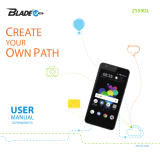
6 7
Connecting to Wi-Fi........................................................... 53
Using Wi-Fi Direct ............................................................. 58
Connecting to Bluetooth Devices ...................................... 59
Connecting to Your Computer via USB ............................. 62
Using the microSDHC Card as Portable or
Device Storage ................................................................. 63
Sharing Your Mobile Data Connection .............................. 67
Connecting to Virtual Private Networks ............................. 70
Phone Calls ............................................................... 72
Placing and Ending Calls .................................................. 72
Answering or Rejecting Calls ............................................ 73
Working With the Call History ........................................... 74
Calling Your Contacts ........................................................ 76
Using Voicemail................................................................. 76
Using Options During a Call .............................................. 78
Managing Multi-party Calls ............................................... 79
Adjusting Your Call Settings .............................................. 81
Contacts .................................................................... 87
Checking Contact Details .................................................. 87
Adding a New Contact ...................................................... 87
Setting Up Your Own Prole ............................................. 88
Importing, Exporting, and Sharing Contacts ..................... 89
Working With Favorite Contacts ........................................ 90
Working With Groups ........................................................ 91
Searching for a Contact .................................................... 93
Editing Contacts ................................................................ 93
Web Accounts ........................................................... 95
Adding or Removing Accounts .......................................... 95
Conguring Account Sync ................................................. 96
Email .......................................................................... 98
Setting Up the First Email Account ................................... 98
Checking Your Emails ....................................................... 98
Writing and Sending an Email ........................................... 99
Responding to an Email .................................................... 99
Adding and Editing Email Accounts ................................ 101
Changing General Email Settings ................................... 102
Messages ................................................................ 103
Opening the Messages Screen ....................................... 103
Sending a Message ........................................................ 103
Replying to a Message ................................................... 105
Forwarding a Message ................................................... 105
Web Browser ........................................................... 106
Opening the Browser ...................................................... 106
Setting the Home Page ................................................... 106
Using Multiple Browser Windows .................................... 107





















